View in other NatureServe Network Field Guides
NatureServe
Montana
Utah
Wyoming
Idaho
Wisconsin
British Columbia
South Carolina
Yukon
California
New York
Least Chipmunk - Neotamias minimus
Other Names:
Tamias minimus
Native Species
Global Rank:
G5
State Rank:
S5
(see State Rank Reason below)
Agency Status
USFWS:
USFS:
BLM:
External Links
State Rank Reason (see State Rank above)
Species is relatively common within suitable habitat and widely distributed across portions of the state
General Description
We do not yet have descriptive information on this species. Please try the buttons above to search for information from other sources.
Species Range
Montana Range
Range Descriptions
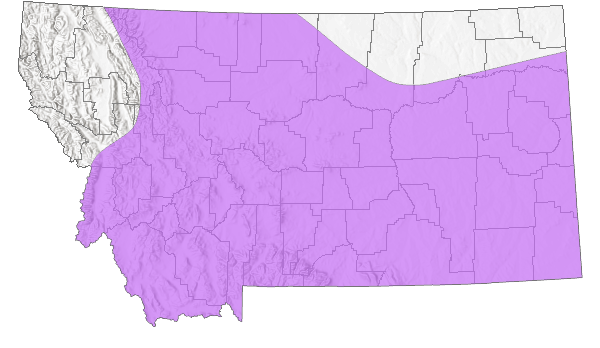
 Native
Native
Western Hemisphere Range

Observations in Montana Natural Heritage Program Database
Number of Observations: 694
(Click on the following maps and charts to see full sized version)
Map Help and Descriptions
Relative Density
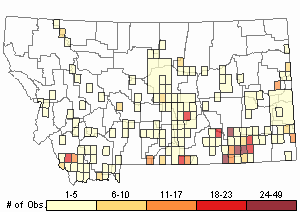
Recency

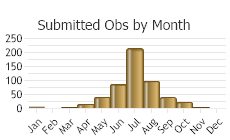
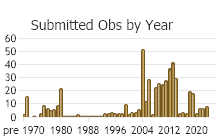
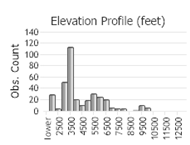 (Observations spanning multiple months or years are excluded from time charts)
(Observations spanning multiple months or years are excluded from time charts)
Migration
Non-migratory.
Habitat
Only chipmunk found regularly in sagebrush area of eastern and southwestern MT. Also found in brushy grasslands, coniferous forests, alpine tundra, and timberline krummholz. Habitat preference influenced by sympatric chipmunk species (Hoffmann and Pattie 1968).
National Vegetation Classification System Groups Associated with this Species
Alpine
Alpine - Sparse and Barren
Alpine - Vegetated
Forest and Woodland
Deciduous Forest and Woodland
Low Elevation - Xeric Forest and Woodland
Montane - Subalpine Forest and Woodland
Shrubland
Arid - Saline Shrubland
Foothills - Montane Shrubland
Sagebrush Shrubland
Grassland
Lowland - Prairie Grassland
Montane - Subalpine Grassland
Sparse and Barren
Sparse and Barren
Wetland and Riparian
Alkaline - Saline Wetlands
Alpine Riparian and Wetland
Riparian and Wetland Forest
Riparian Shrubland
Recently Disturbed or Modified
Insect-Killed Forest
Human Land Use
Developed
Food Habits
Seeds and berries. Uses berry pits, seeds of grasses, sedges, and weeds. Stores food. Also uses invertebrates.
Ecology
T. minimus ordinarily inhabits lower elevation, drier habitats than T. amoenus or T. ruficaudus. However, in Glacier National Park area, T. minimus occupies the alpine and T. ruficaudus and T. amoenus occur at lower elevations.
Reproductive Characteristics
Breeds soon after emergence. Young are independent within 2 months. (Jones et al. 1983).
Stewardship Responsibility
References
- Literature Cited AboveLegend:
 View Online Publication
View Online Publication Hoffmann, R.S. and D.L. Pattie. 1968. A guide to Montana mammals: identification, habitat, distribution, and abundance. Missoula, MT: University of Montana. 133 p.
Hoffmann, R.S. and D.L. Pattie. 1968. A guide to Montana mammals: identification, habitat, distribution, and abundance. Missoula, MT: University of Montana. 133 p. Jones, J.K., D.M. Armstrong, R.S. Hoffmann and C. Jones. 1983. Mammals of the northern Great Plains. University of Nebraska Press, Lincoln. 379 pp.
Jones, J.K., D.M. Armstrong, R.S. Hoffmann and C. Jones. 1983. Mammals of the northern Great Plains. University of Nebraska Press, Lincoln. 379 pp.
- Additional ReferencesLegend:
 View Online Publication
View Online Publication
Do you know of a citation we're missing? [PRESI] Powder River Eagle Studies Incorporated. 1998b. Spring Creek Mine 1997 wildlife monitoring studies. Powder River Eagle Studies Incorporated. Gillete, WY.
[PRESI] Powder River Eagle Studies Incorporated. 1998b. Spring Creek Mine 1997 wildlife monitoring studies. Powder River Eagle Studies Incorporated. Gillete, WY. Allen, K.L., T. Weaver, and D. Flath. 1994. Small mammals in Northern Rocky Mountain ecosystems. Unpubl. report to Bureau of Land Management and United States Forest Service, August 31, 1994. Montana State Univ., Bozeman. 54 pp.
Allen, K.L., T. Weaver, and D. Flath. 1994. Small mammals in Northern Rocky Mountain ecosystems. Unpubl. report to Bureau of Land Management and United States Forest Service, August 31, 1994. Montana State Univ., Bozeman. 54 pp. Anaconda Minerals Company, and Camp, Dresser & McKee. 1981. Anaconda Stillwater Project 6-month environmental baseline report. CDM Project No. 3139. Vol. I Appendix. Jan. 15, 1981.
Anaconda Minerals Company, and Camp, Dresser & McKee. 1981. Anaconda Stillwater Project 6-month environmental baseline report. CDM Project No. 3139. Vol. I Appendix. Jan. 15, 1981. Bachen, D.A. 2014. Cheatgrass invasion of sagebrush steppe: Impacts of vegetation structure on small mammals. M.Sc. Thesis. Bozeman, Montana: Montana State University. 96 p.
Bachen, D.A. 2014. Cheatgrass invasion of sagebrush steppe: Impacts of vegetation structure on small mammals. M.Sc. Thesis. Bozeman, Montana: Montana State University. 96 p. Beak Consultants, Inc. 1983. Wildlife. January 1983. In Stillwater Project Environmental Studies. Addendum A, Wildlife. Vol. I. Tech. Report No. 7. 1982.
Beak Consultants, Inc. 1983. Wildlife. January 1983. In Stillwater Project Environmental Studies. Addendum A, Wildlife. Vol. I. Tech. Report No. 7. 1982. Becker, D.M. 1984. Reproductive ecology and habitat utilization of Richardson's Merlins in southeastern Montana. M.Sc. Thesis. Missoula, MT: University of Montana. 62 p.
Becker, D.M. 1984. Reproductive ecology and habitat utilization of Richardson's Merlins in southeastern Montana. M.Sc. Thesis. Missoula, MT: University of Montana. 62 p. Buck, C.L. 1939. Pattern correlation of mammalian teeth as a means of identification. M.Sc. Thesis. Bozeman, Montana: Montana State University. 55 p.
Buck, C.L. 1939. Pattern correlation of mammalian teeth as a means of identification. M.Sc. Thesis. Bozeman, Montana: Montana State University. 55 p. Coffin, K.W. 1994. Population characteristics and winter habitat selection by pine marten in southwest Montana. M.Sc. Thesis. Bozeman, MT: Montana State University. 94 p.
Coffin, K.W. 1994. Population characteristics and winter habitat selection by pine marten in southwest Montana. M.Sc. Thesis. Bozeman, MT: Montana State University. 94 p. Dames & Moore. 1975. Interim report environmental baseline studies for Crow Indian coal leases: known as Tract II and Tract III, Westmoreland Resources, Sarpy Creek Basin, Big Horn County, Montana. Billings, Mont.
Dames & Moore. 1975. Interim report environmental baseline studies for Crow Indian coal leases: known as Tract II and Tract III, Westmoreland Resources, Sarpy Creek Basin, Big Horn County, Montana. Billings, Mont. Dood, A.R. 1980. Terry Badlands nongame survey and inventory final report. Montana Department of Fish, Wildlife, and Parks and Bureau of Land Management, Helena, MT. 70 pp.
Dood, A.R. 1980. Terry Badlands nongame survey and inventory final report. Montana Department of Fish, Wildlife, and Parks and Bureau of Land Management, Helena, MT. 70 pp. Ecological Consulting Service, Helena, MT., 1975, Peabody Coal Company Big Sky Mine: Wildlife environmental indicators monitoring survey. Progress report. Project 58-23-A. June 16, 1975.
Ecological Consulting Service, Helena, MT., 1975, Peabody Coal Company Big Sky Mine: Wildlife environmental indicators monitoring survey. Progress report. Project 58-23-A. June 16, 1975. ECON, Inc. (Ecological Consulting Service), Helena, MT., 1976, Colstrip 10 x 20 Area wildlife and wildlife habitat annual monitoring report, 1976. Proj. 135-85-A. December 31, 1976.
ECON, Inc. (Ecological Consulting Service), Helena, MT., 1976, Colstrip 10 x 20 Area wildlife and wildlife habitat annual monitoring report, 1976. Proj. 135-85-A. December 31, 1976. Econ, Inc. (Ecological Consulting Service), Helena, MT., 1977, 1977 wildlife and wildlife habitat monitoring study, Peabody Coal Company Big Sky Mine. Proj. 161-85-A. November 30, 1977.
Econ, Inc. (Ecological Consulting Service), Helena, MT., 1977, 1977 wildlife and wildlife habitat monitoring study, Peabody Coal Company Big Sky Mine. Proj. 161-85-A. November 30, 1977. ECON, Inc. (Ecological Consulting Service), Helena, MT., 1977, Colstrip 10 x 20 Area wildlife and wildlife habitat annual monitoring report, 1977. Proj. 164-85-A. December 31, 1977.
ECON, Inc. (Ecological Consulting Service), Helena, MT., 1977, Colstrip 10 x 20 Area wildlife and wildlife habitat annual monitoring report, 1977. Proj. 164-85-A. December 31, 1977. ECON, Inc. (Ecological Consulting Service), Helena, MT., 1979, Annual wildllife report of the Colstrip Area for 1978. Proj. 195-85-A. April 6, 1979.
ECON, Inc. (Ecological Consulting Service), Helena, MT., 1979, Annual wildllife report of the Colstrip Area for 1978. Proj. 195-85-A. April 6, 1979. ECON, Inc. (Ecological Consulting Service), Helena, MT., 1979, Annual wildllife report of the Colstrip Area for 1979, including a special raptor research study. Proj. 216-85-A. March 1, 1980.
ECON, Inc. (Ecological Consulting Service), Helena, MT., 1979, Annual wildllife report of the Colstrip Area for 1979, including a special raptor research study. Proj. 216-85-A. March 1, 1980. ECON, Inc. (Ecological Consulting Service), Helena, MT., 1979, Area B four-section wildlife report. August 3, 1979.
ECON, Inc. (Ecological Consulting Service), Helena, MT., 1979, Area B four-section wildlife report. August 3, 1979. Econ, Inc., Helena, MT., 1978, Peabody Coal Company Big Sky Mine, Rosebud County, MT. Wildlife and wildlife habitat monitoring study. Proj. 190-85-A. December 31, 1978.
Econ, Inc., Helena, MT., 1978, Peabody Coal Company Big Sky Mine, Rosebud County, MT. Wildlife and wildlife habitat monitoring study. Proj. 190-85-A. December 31, 1978. Elliott, Joe C. and Hydrometrics, Inc., Helena, MT., 1994, Supplement to wildlife baseline investigation life-of-mine expansion plan: Regal Mine, Barretts Minerals, Inc., Madison County, Montana. August 2000. In Life-of Mine Expansion Plan: Barretts Minerals, Inc., Regal Mine, Madison County, Montana. Vol. 2. App. C: Baseline Wildlife Reconnaissance. December 1999.
Elliott, Joe C. and Hydrometrics, Inc., Helena, MT., 1994, Supplement to wildlife baseline investigation life-of-mine expansion plan: Regal Mine, Barretts Minerals, Inc., Madison County, Montana. August 2000. In Life-of Mine Expansion Plan: Barretts Minerals, Inc., Regal Mine, Madison County, Montana. Vol. 2. App. C: Baseline Wildlife Reconnaissance. December 1999. Feldhamer, G.A. 1979. Vegetative and edaphic features affecting the abundance and distribution of small mammals in southeast Oregon. Great Basin Nat. 39:207-218.
Feldhamer, G.A. 1979. Vegetative and edaphic features affecting the abundance and distribution of small mammals in southeast Oregon. Great Basin Nat. 39:207-218. Fjell, Alan K., 1986, Peabody Coal Company Big Sky Mine, Rosebud County, MT. Wildlife monitoring report: 1985 field season. March 1986.
Fjell, Alan K., 1986, Peabody Coal Company Big Sky Mine, Rosebud County, MT. Wildlife monitoring report: 1985 field season. March 1986. Fjell, Alan K., and Brian R. Mahan, compilers., 1984, Peabody Coal Company Big Sky Mine, Rosebud County, MT. Wildlife monitoring report: 1983 field season. February 1984.
Fjell, Alan K., and Brian R. Mahan, compilers., 1984, Peabody Coal Company Big Sky Mine, Rosebud County, MT. Wildlife monitoring report: 1983 field season. February 1984. Fjell, Alan K., and Brian R. Mahan., 1983, Peabody Coal Company Big Sky Mine, Rosebud County, MT. Wildlife monitoring report: 1982 field season. May 1983.
Fjell, Alan K., and Brian R. Mahan., 1983, Peabody Coal Company Big Sky Mine, Rosebud County, MT. Wildlife monitoring report: 1982 field season. May 1983. Fjell, Alan K., and Brian R. Mahan., 1985, Peabody Coal Company Big Sky Mine, Rosebud County, MT. Wildlife monitoring report: 1984 field season. February 1985.
Fjell, Alan K., and Brian R. Mahan., 1985, Peabody Coal Company Big Sky Mine, Rosebud County, MT. Wildlife monitoring report: 1984 field season. February 1985. Fjell, Alan K., and Brian R. Mahan., 1987, Big Sky Mine, Rosebud County, MT. Wildlife monitoring report: 1986 field season. April 1987.
Fjell, Alan K., and Brian R. Mahan., 1987, Big Sky Mine, Rosebud County, MT. Wildlife monitoring report: 1986 field season. April 1987. Foresman, K.R. 2001. The wild mammals of Montana. American Society of Mammalogists, Special Publication Number 12. Lawrence, KS. 278 pp.
Foresman, K.R. 2001. The wild mammals of Montana. American Society of Mammalogists, Special Publication Number 12. Lawrence, KS. 278 pp. Foresman, K.R. 2012. Mammals of Montana. Second edition. Mountain Press Publishing, Missoula, Montana. 429 pp.
Foresman, K.R. 2012. Mammals of Montana. Second edition. Mountain Press Publishing, Missoula, Montana. 429 pp. Geppert, T. J. 1984. Small mammals of the Shield Trap, East Pryor Mountain, Montana. M.S. thesis. University of Iowa, Iowa City. 45 pp.
Geppert, T. J. 1984. Small mammals of the Shield Trap, East Pryor Mountain, Montana. M.S. thesis. University of Iowa, Iowa City. 45 pp. Hanauska-Brown, L., B.A. Maxell, A. Petersen, and S. Story. 2014. Diversity Monitoring in Montana 2008-2010 Final Report. Montana Fish, Wildlife & Parks. Helena, MT. 78 pp.
Hanauska-Brown, L., B.A. Maxell, A. Petersen, and S. Story. 2014. Diversity Monitoring in Montana 2008-2010 Final Report. Montana Fish, Wildlife & Parks. Helena, MT. 78 pp. Hendricks, P. and M. Roedel. 2001. A faunal survey of the Centennial Valley Sandhills, Beaverhead County, Montana. Report to the U.S. Bureau of Land Management and U.S. Fish and Wildlife Service. Montana Natural Heritage Program, Helena, MT. 44 p.
Hendricks, P. and M. Roedel. 2001. A faunal survey of the Centennial Valley Sandhills, Beaverhead County, Montana. Report to the U.S. Bureau of Land Management and U.S. Fish and Wildlife Service. Montana Natural Heritage Program, Helena, MT. 44 p. Holmes, Brian. 2003. Ecology and Persistence of Sylvatic Plague in Phillips County, Montana. MS Thesis. University of Montana, Missoula, MT.
Holmes, Brian. 2003. Ecology and Persistence of Sylvatic Plague in Phillips County, Montana. MS Thesis. University of Montana, Missoula, MT. Humphris, Michael., 1990, Wildlife Monitoring Report. Spring Creek Coal Company 1990 Mining Annual Report. Appendix I. April 11, 1990.
Humphris, Michael., 1990, Wildlife Monitoring Report. Spring Creek Coal Company 1990 Mining Annual Report. Appendix I. April 11, 1990. Humphris, Michael., 1993, Wildlife Monitoring Report. Spring Creek Coal Company 1993 Mining Annual Report. Appendix I. April 11, 1993.
Humphris, Michael., 1993, Wildlife Monitoring Report. Spring Creek Coal Company 1993 Mining Annual Report. Appendix I. April 11, 1993. Humphris, Michael., 1994, Wildlife Monitoring Report. Spring Creek Coal Company 1994 Mining Annual Report. Appendix I. April 1994.
Humphris, Michael., 1994, Wildlife Monitoring Report. Spring Creek Coal Company 1994 Mining Annual Report. Appendix I. April 1994. Joslin, Gayle, and Heidi B. Youmans. 1999. Effects of recreation on Rocky Mountain wildlife: a review for Montana. [Montana]: Montana Chapter of the Wildlife Society.
Joslin, Gayle, and Heidi B. Youmans. 1999. Effects of recreation on Rocky Mountain wildlife: a review for Montana. [Montana]: Montana Chapter of the Wildlife Society. Klaus, M. 1997. Dispersal of Microtus richardsoni in the Beartooth Mountains of Montana and Wyoming. Ph.D. Dissertation. Bozeman, MT: Montana State University. 56 p.
Klaus, M. 1997. Dispersal of Microtus richardsoni in the Beartooth Mountains of Montana and Wyoming. Ph.D. Dissertation. Bozeman, MT: Montana State University. 56 p. Lampe, R.P., J.K. Jones Jr., R.S. Hoffmann, and E.C. Birney. 1974. The mammals of Carter County, southeastern Montana. Occa. Pap. Mus. Nat. Hist. Univ. Kan. 25:1-39.
Lampe, R.P., J.K. Jones Jr., R.S. Hoffmann, and E.C. Birney. 1974. The mammals of Carter County, southeastern Montana. Occa. Pap. Mus. Nat. Hist. Univ. Kan. 25:1-39. Landusky Mining Inc., Zortman, MT. Assisted by Hydrometrics, Helena, MT., 1985, Operating Permit Application for an Extension of Landusky Mining Incorporated Operations, Phillips County, Montana. June 12, 1985
Landusky Mining Inc., Zortman, MT. Assisted by Hydrometrics, Helena, MT., 1985, Operating Permit Application for an Extension of Landusky Mining Incorporated Operations, Phillips County, Montana. June 12, 1985 MacCracken, J.G., D.W. Uresk, and R.M. Hansen. 1985. Rodent-vegetation relationships in southeastern Montana. Northwest Science 59:272-278.
MacCracken, J.G., D.W. Uresk, and R.M. Hansen. 1985. Rodent-vegetation relationships in southeastern Montana. Northwest Science 59:272-278. Martin, P.R., K. Dubois and H.B. Youmans. 1981. Terrestrial wildlife inventory in selected coal areas, Powder River resources area final report. Montana Department of Fish, Wildlife and Parks and Bureau of Land Management, Helena, MT. No. YA-553-CTO- 24. 288 p.
Martin, P.R., K. Dubois and H.B. Youmans. 1981. Terrestrial wildlife inventory in selected coal areas, Powder River resources area final report. Montana Department of Fish, Wildlife and Parks and Bureau of Land Management, Helena, MT. No. YA-553-CTO- 24. 288 p. Matthews, W.L. 1980a. Wibaux-Beach comparison study: Sydney, Glendive and Plevna Study Areas. Bureau of Land Management, Miles City, MT. 50 p.
Matthews, W.L. 1980a. Wibaux-Beach comparison study: Sydney, Glendive and Plevna Study Areas. Bureau of Land Management, Miles City, MT. 50 p. Matthews, W.L. 1981. Broadus-Pumpkin Creek baseline inventory - wildlife. Bureau of Land Management, Miles City, MT. 83 p.
Matthews, W.L. 1981. Broadus-Pumpkin Creek baseline inventory - wildlife. Bureau of Land Management, Miles City, MT. 83 p. Maxell, B.A. 2016. Northern Goshawk surveys on the Beartooth, Ashland, and Sioux Districts of the Custer-Gallatin National Forest: 2012-2014. Montana Natural Heritage Program. Helena, MT. 114pp.
Maxell, B.A. 2016. Northern Goshawk surveys on the Beartooth, Ashland, and Sioux Districts of the Custer-Gallatin National Forest: 2012-2014. Montana Natural Heritage Program. Helena, MT. 114pp. Maxim Technologies, Inc., 2002, Western Energy Company Rosebud Mine, Colstrip, Montana: 2002 Annual Wildlife Monitoring Report; December 1, 2001 - November 30, 2002. Febr. 24, 2002.
Maxim Technologies, Inc., 2002, Western Energy Company Rosebud Mine, Colstrip, Montana: 2002 Annual Wildlife Monitoring Report; December 1, 2001 - November 30, 2002. Febr. 24, 2002. Morrison-Maierle Env. Corp., Helena, MT., 1993, Biological assessment and wildlife reconnaissance, Holnam Cement Plant, Trident, Montana. In Application to Amend Operating Permit 00004 for Trident Quarries, Three Forks, Montana. Exhibit DD: Wildlife Reconnaisance Study. June 28, 1996.
Morrison-Maierle Env. Corp., Helena, MT., 1993, Biological assessment and wildlife reconnaissance, Holnam Cement Plant, Trident, Montana. In Application to Amend Operating Permit 00004 for Trident Quarries, Three Forks, Montana. Exhibit DD: Wildlife Reconnaisance Study. June 28, 1996. Newlon, K.R. 2005. Demography of Lewis's Woodpecker, breeding bird densities, and riparian Aspen integrity in a grazed landscape. M.Sc. Thesis. Bozeman, MT: Montana State University. 101 p.
Newlon, K.R. 2005. Demography of Lewis's Woodpecker, breeding bird densities, and riparian Aspen integrity in a grazed landscape. M.Sc. Thesis. Bozeman, MT: Montana State University. 101 p. Oechsli, L.M. 2000. Ex-urban development in the Rocky Mountain West: consequences for native vegetation, wildlife diversity, and land-use planning in Big Sky, Montana. M.Sc. Thesis. Montana State University, Bozeman. 73 p.
Oechsli, L.M. 2000. Ex-urban development in the Rocky Mountain West: consequences for native vegetation, wildlife diversity, and land-use planning in Big Sky, Montana. M.Sc. Thesis. Montana State University, Bozeman. 73 p. Pattie, D.L. and N.A. M. Verbeek. 1967. Alpine mammals of the Beartooth Plateau. Northwest Science 41(3): 110-117.
Pattie, D.L. and N.A. M. Verbeek. 1967. Alpine mammals of the Beartooth Plateau. Northwest Science 41(3): 110-117. Powder River Eagle Studies, Inc., Gillette, WY., 1995, Spring Creek Mine 1994 Wildlife Monitoring Studies. 4/94 to 4/95. Spring Creek Coal Company 1995 Mining Annual Report. Appendix I. May 1995.
Powder River Eagle Studies, Inc., Gillette, WY., 1995, Spring Creek Mine 1994 Wildlife Monitoring Studies. 4/94 to 4/95. Spring Creek Coal Company 1995 Mining Annual Report. Appendix I. May 1995. Powder River Eagle Studies, Inc., Gillette, WY., 1996, Spring Creek Mine 1995 Wildlife Monitoring Studies. Spring Creek Coal Company 1995-1996 Mining Annual Report. Vol. I, App. I. May 1996.
Powder River Eagle Studies, Inc., Gillette, WY., 1996, Spring Creek Mine 1995 Wildlife Monitoring Studies. Spring Creek Coal Company 1995-1996 Mining Annual Report. Vol. I, App. I. May 1996. Powder River Eagle Studies, Inc., Gillette, WY., 1997, Spring Creek Mine 1996 Wildlife Monitoring Studies. February 1997.
Powder River Eagle Studies, Inc., Gillette, WY., 1997, Spring Creek Mine 1996 Wildlife Monitoring Studies. February 1997. Powder River Eagle Studies, Inc., Gillette, WY., 1999, Spring Creek Mine 1998 Wildlife Monitoring. March 1999.
Powder River Eagle Studies, Inc., Gillette, WY., 1999, Spring Creek Mine 1998 Wildlife Monitoring. March 1999. Reid, F. 2006. Peterson Field Guide to Mammals of North America, 4th Edition. Houghton Mifflin Company: Boston and New York, 608 pp.
Reid, F. 2006. Peterson Field Guide to Mammals of North America, 4th Edition. Houghton Mifflin Company: Boston and New York, 608 pp. Scow, K.L. 1981. Ecological distribution of small mammals at Sarpy Creek, Montana, with special consideration of the Deer Mouse, Peromyscus maniculatus. M.Sc. Thesis. Bozeman, Montana: Montana State University. 73 p.
Scow, K.L. 1981. Ecological distribution of small mammals at Sarpy Creek, Montana, with special consideration of the Deer Mouse, Peromyscus maniculatus. M.Sc. Thesis. Bozeman, Montana: Montana State University. 73 p. Spring Creek Coal Company., 1992, Wildlife Monitoring Report. Spring Creek Coal Company 1992 Mining Annual Report. Appendix I.
Spring Creek Coal Company., 1992, Wildlife Monitoring Report. Spring Creek Coal Company 1992 Mining Annual Report. Appendix I. Sullivan, R.M. 1985. Phyletic, biogeographic, and ecologic relationships among montane populations of least chipmunks (Eutamias minimus). Syst. Zool. 34:419-448.
Sullivan, R.M. 1985. Phyletic, biogeographic, and ecologic relationships among montane populations of least chipmunks (Eutamias minimus). Syst. Zool. 34:419-448. Thompson, L.S. 1981. Circle West wildlife monitoring study: Third annual report. Technical report No. 8. Montana Department of Natural Resources and Conservation. Helena, Montana.
Thompson, L.S. 1981. Circle West wildlife monitoring study: Third annual report. Technical report No. 8. Montana Department of Natural Resources and Conservation. Helena, Montana. Thunderbird Wildlife Consulting, Inc., Gillette, WY., 2003, 2002 wildlife monitoring report: Big Sky Mine. February 2003.
Thunderbird Wildlife Consulting, Inc., Gillette, WY., 2003, 2002 wildlife monitoring report: Big Sky Mine. February 2003. Van Horn, R.C. 1993. Ferruginous Hawk and Prairie Falcon reproductive and behavioral responses to human activity near the Kevin Rim, Montana. M.Sc. Thesis. Bozeman, Montana: Montana State University. 86 p.
Van Horn, R.C. 1993. Ferruginous Hawk and Prairie Falcon reproductive and behavioral responses to human activity near the Kevin Rim, Montana. M.Sc. Thesis. Bozeman, Montana: Montana State University. 86 p. Verts, B. J. and L. N. Carraway. 2001. Neotamias minimus. American Society of Mammalogists, Lawrence, KS. Mammalian Species No. 653:1-10.
Verts, B. J. and L. N. Carraway. 2001. Neotamias minimus. American Society of Mammalogists, Lawrence, KS. Mammalian Species No. 653:1-10. VTN Colorado, Inc. Decker Coal Company., 1975, Draft environmental impact assessment for the proposed North Extension of the West Decker Mine.
VTN Colorado, Inc. Decker Coal Company., 1975, Draft environmental impact assessment for the proposed North Extension of the West Decker Mine. Waage, B.C. 1988. Western Energy Company Rosebud Mine, Colstrip, Montana: Annual Wildlife Monitoring Report, 1988 Field Season. December 1988.
Waage, B.C. 1988. Western Energy Company Rosebud Mine, Colstrip, Montana: Annual Wildlife Monitoring Report, 1988 Field Season. December 1988. Waage, Bruce C., 1995, Western Energy Company Rosebud Mine, Colstrip, Montana:1994 Annual Wildlife Monitoring Report; December 1, 1993 - November 30, 1994. February 27, 1995.
Waage, Bruce C., 1995, Western Energy Company Rosebud Mine, Colstrip, Montana:1994 Annual Wildlife Monitoring Report; December 1, 1993 - November 30, 1994. February 27, 1995. Waage, Bruce C., 1996, Western Energy Company Rosebud Mine, Colstrip, Montana: 1995 Annual Wildlife Monitoring Report; December 1, 1994 - November 30, 1995. February 28, 1996.
Waage, Bruce C., 1996, Western Energy Company Rosebud Mine, Colstrip, Montana: 1995 Annual Wildlife Monitoring Report; December 1, 1994 - November 30, 1995. February 28, 1996. Waage, Bruce C., 1998, Western Energy Company Rosebud Mine, Colstrip, Montana: 1997 Annual Wildlife Monitoring Report; December 1, 1996 - November 30, 1997 Survey Period. March 23, 1998.
Waage, Bruce C., 1998, Western Energy Company Rosebud Mine, Colstrip, Montana: 1997 Annual Wildlife Monitoring Report; December 1, 1996 - November 30, 1997 Survey Period. March 23, 1998. Waage, Bruce C., 1999, Western Energy Company Rosebud Mine, Colstrip, Montana: 1998 Annual Wildlife Monitoring Report; December 1, 1997 - November 30, 1998 Survey Period. February 24, 1999.
Waage, Bruce C., 1999, Western Energy Company Rosebud Mine, Colstrip, Montana: 1998 Annual Wildlife Monitoring Report; December 1, 1997 - November 30, 1998 Survey Period. February 24, 1999. Waage, Bruce C., 2001, Western Energy Company Rosebud Mine, Colstrip, Montana: 2000 Annual Wildlife Monitoring Report; December 1, 1999 - November 30, 2000. March 30, 2001.
Waage, Bruce C., 2001, Western Energy Company Rosebud Mine, Colstrip, Montana: 2000 Annual Wildlife Monitoring Report; December 1, 1999 - November 30, 2000. March 30, 2001. Walters, B. B. 1991. Small mammals in subalpine old-growth forest and clearcuts. Northwest Sci. 65(1):27-31.
Walters, B. B. 1991. Small mammals in subalpine old-growth forest and clearcuts. Northwest Sci. 65(1):27-31. WESTECH Env. Services, Inc., Helena, MT., 2000, Reconnaissance of Wildlife and Fisheries Resources at the Ruby Garnet Alder Gulch Property. May 24, 2000. In Application for an Operating Permit and Proposed Plan of Operations, Alder Gulch Mine Project, Mad
WESTECH Env. Services, Inc., Helena, MT., 2000, Reconnaissance of Wildlife and Fisheries Resources at the Ruby Garnet Alder Gulch Property. May 24, 2000. In Application for an Operating Permit and Proposed Plan of Operations, Alder Gulch Mine Project, Mad Westech, Inc. [Western Technology and Engineering]. No date. Preliminary wildlife reconnaissance, Ruby and Little Ben mine areas, Little Rocky Mountains, Montana. Technical Report for Zortman and Landusky Mining Companies.
Westech, Inc. [Western Technology and Engineering]. No date. Preliminary wildlife reconnaissance, Ruby and Little Ben mine areas, Little Rocky Mountains, Montana. Technical Report for Zortman and Landusky Mining Companies. Western Energy Co., Colstrip, MT. Unpub., 1983, Western Energy Company's Application for Amendment to Surface Mining Permit NO. 8003, Area B: sections 7, 8, 17,18 T1N R41E, sections 12, 13 T1N R40E, Mining Expansion. March 1983.
Western Energy Co., Colstrip, MT. Unpub., 1983, Western Energy Company's Application for Amendment to Surface Mining Permit NO. 8003, Area B: sections 7, 8, 17,18 T1N R41E, sections 12, 13 T1N R40E, Mining Expansion. March 1983. Western Technology & Engineering, Inc. (WESTECH)., 1991, 1991 Bull Mountains Mine No. 1 Terrestrial Wildlife Monitoring Study. In Meridian Minerals Company Bull Mountains Mine No. 1 Permit Application, Musselshell County, Montana. Vol. 7 of 14: Section 26
Western Technology & Engineering, Inc. (WESTECH)., 1991, 1991 Bull Mountains Mine No. 1 Terrestrial Wildlife Monitoring Study. In Meridian Minerals Company Bull Mountains Mine No. 1 Permit Application, Musselshell County, Montana. Vol. 7 of 14: Section 26 Western Technology and Engineering, Inc. (WESTECH), Helena, MT., 1994, Terrestrial Wildlife Reconnaissance: Interim Report. Golden Sunlight Mines, Inc., Oxide Expansion. February 1994.
Western Technology and Engineering, Inc. (WESTECH), Helena, MT., 1994, Terrestrial Wildlife Reconnaissance: Interim Report. Golden Sunlight Mines, Inc., Oxide Expansion. February 1994. Western Technology and Engineering, Inc. (WESTECH). 1994. Wildlife Monitoring Absaloka Mine Area Annual Report, 1993. Montana SMP 85005. OSMP Montana 0007c. Mar. 12, 1994.
Western Technology and Engineering, Inc. (WESTECH). 1994. Wildlife Monitoring Absaloka Mine Area Annual Report, 1993. Montana SMP 85005. OSMP Montana 0007c. Mar. 12, 1994. Western Technology and Engineering, Inc. (WESTECH)., 1993, Wildlife Monitoring Asaloka Mine Area Annual Report, 1992. Montana SMP 85005 R1. OSMP Montana 00078. 1993.
Western Technology and Engineering, Inc. (WESTECH)., 1993, Wildlife Monitoring Asaloka Mine Area Annual Report, 1992. Montana SMP 85005 R1. OSMP Montana 00078. 1993. Western Technology and Engineering, Inc. (WESTECH)., 1994, Wildlife Monitoring Absaloka Mine Area Annual Report, 1994. Montana SMP 85005. OSMP Montana 0007D. Febr. 24, 1994.
Western Technology and Engineering, Inc. (WESTECH)., 1994, Wildlife Monitoring Absaloka Mine Area Annual Report, 1994. Montana SMP 85005. OSMP Montana 0007D. Febr. 24, 1994. Western Technology and Engineering, Inc. (WESTECH)., 1996, Wildlife Monitoring Absaloka Mine Area Annual Report, 1995. Montana SMP 85005. OSMP Montana 0007D. Febr. 23, 1996.
Western Technology and Engineering, Inc. (WESTECH)., 1996, Wildlife Monitoring Absaloka Mine Area Annual Report, 1995. Montana SMP 85005. OSMP Montana 0007D. Febr. 23, 1996. Western Technology and Engineering, Inc. (WESTECH)., 1997, Wildlife Monitoring Absaloka Mine Area Annual Report, 1996. Montana SMP 85005. OSMP Montana 0007D. Mar. 1997.
Western Technology and Engineering, Inc. (WESTECH)., 1997, Wildlife Monitoring Absaloka Mine Area Annual Report, 1996. Montana SMP 85005. OSMP Montana 0007D. Mar. 1997. Western Technology and Engineering, Inc. (WESTECH)., 1999, Wildlife Monitoring Absaloka Mine Area Annual Report, 1998. SMP 85005. OSMP Montana 0007E. April 1999.
Western Technology and Engineering, Inc. (WESTECH)., 1999, Wildlife Monitoring Absaloka Mine Area Annual Report, 1998. SMP 85005. OSMP Montana 0007E. April 1999. Western Technology and Engineering, Inc. (WESTECH)., 2000, Wildlife Monitoring Absaloka Mine Area Annual Report, 1999. Montana SMP 85005. OSMP Montana 0007E. February 2000.
Western Technology and Engineering, Inc. (WESTECH)., 2000, Wildlife Monitoring Absaloka Mine Area Annual Report, 1999. Montana SMP 85005. OSMP Montana 0007E. February 2000. Western Technology and Engineering, Inc. (WESTECH)., 2001, Wildlife Monitoring Absaloka Mine Area Annual Report, 2000. Montana SMP 85005. OSMP Montana 0007E. February 2001.
Western Technology and Engineering, Inc. (WESTECH)., 2001, Wildlife Monitoring Absaloka Mine Area Annual Report, 2000. Montana SMP 85005. OSMP Montana 0007E. February 2001. Western Technology and Engineering, Inc., Helena, MT., 1989, Reconnaissance of the wildlife resources in the vicinity of the Kendall Venture Mine. January 1989. In Kendall Venture North Moccasin Project: Amendment to Operating Permit 00122, Fergus County, Montana. Vol. 2, App. A, Feb., 1989.
Western Technology and Engineering, Inc., Helena, MT., 1989, Reconnaissance of the wildlife resources in the vicinity of the Kendall Venture Mine. January 1989. In Kendall Venture North Moccasin Project: Amendment to Operating Permit 00122, Fergus County, Montana. Vol. 2, App. A, Feb., 1989.
- Web Search Engines for Articles on "Least Chipmunk"
- Additional Sources of Information Related to "Mammals"





